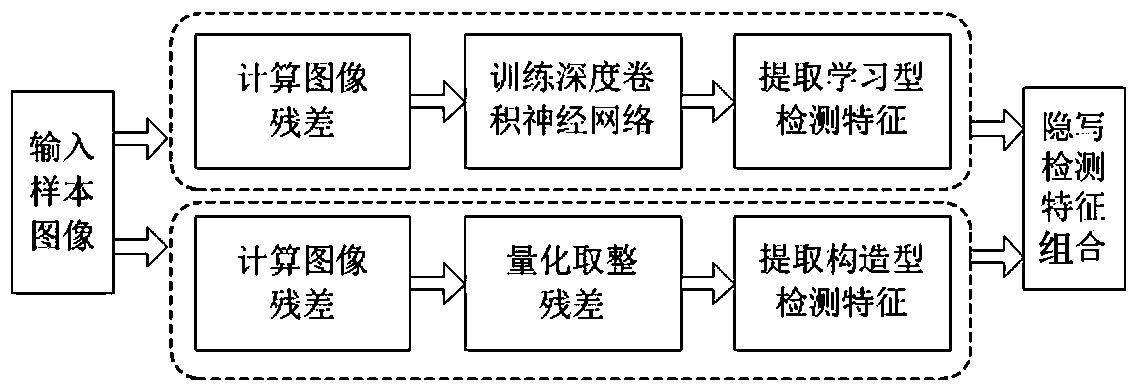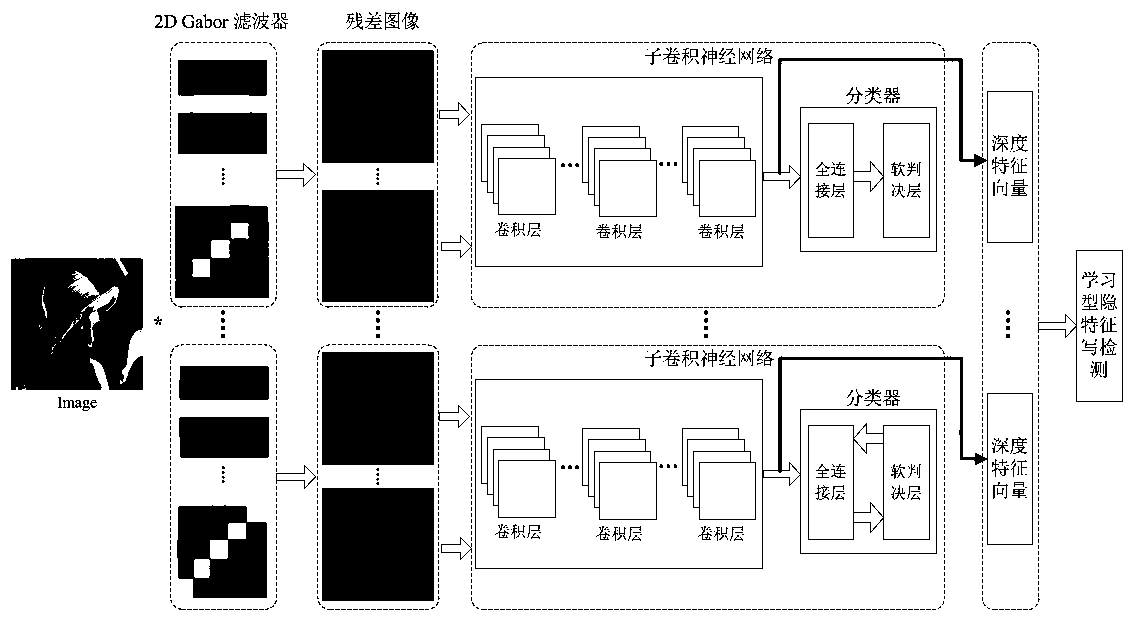Image steganography detection method based on Gabor filtering and convolutional neural network
A convolutional neural network and steganographic detection technology, applied in the field of information hiding, can solve problems such as high detection error rate, complementarity of learning-type steganographic detection features to be studied, and insufficient types of image processing layer filters to achieve detection The effect of reducing the error rate and reducing the detection error rate
- Summary
- Abstract
- Description
- Claims
- Application Information
AI Technical Summary
Problems solved by technology
Method used
Image
Examples
Embodiment 1
[0045] The image steganographic detection method based on Gabor filter and convolutional neural network of the present invention comprises the following steps: generating a carrier image and a secret image sample, figure 1 The learning-type steganographic detection feature and the stereotyped steganographic detection feature of the sample image are extracted as shown, and the above-mentioned learning-type steganographic detection feature and the stereotyped steganographic detection feature are combined as the steganographic detection feature of the sample image; as figure 2 As shown, the extraction steps of learning-type steganographic detection features include: firstly use the multi-scale and multi-directional 2D Gabor filter to filter the JPEG image, and then use the filtered images obtained by the 2D Gabor filter with the same scale parameters to train the depth convolution Then, the sample image is subjected to multi-scale and multi-directional 2D Gabor filtering, and the...
Embodiment 2
[0053] On the basis of Embodiment 1, using different groups of 2D Gabor filters to generate residual images, and then using the residual images to train multiple deep convolutional neural networks and realize learning-type feature extraction includes the following steps:
[0054] Step1: Generate four sets of 2D Gabor filters with different parameters
[0055] Use the 2D Gabor function shown in the following formula to generate a 2D Gabor filter,
[0056]
[0057] Wherein, x'=xcosθ+ysinθ, y'=-xsinθ+ycosθ, σ=0.56λ, γ=0.5.
[0058] The generation steps of the 2D Gabor filter are: (1) generating sampling points. Assuming that the size of the 2D Gabor filter is M×N, the value range of x is The value range of y is Generate sampling points (x, y) with a step size of 1; (2) Determine the filter parameters. Determine the parameters σ, θ and Calculate the value of the parameter λ, γ=0.5; (3) Generate a 2D Gabor filter. According to the 2D Gabor function expression and parame...
Embodiment 3
[0068] Such as image 3 In the present invention shown, different groups of 2D Gabor filters are used to generate filtered residual images, and then different step lengths are used to quantize the residual images, and finally histogram feature extraction is performed on the quantized residual images. Specific steps are as follows:
[0069] Step1: Decompress the JPEG image to the airspace without rounding;
[0070] Step2: Generate a 2D Gabor filter bank, the scale parameter σ is 0.75, 1, 1.25 and 1.5, the direction parameter σ corresponding to each scale is respectively {0, π / 16, 2π / 16,...,15π / 16}, and the phase offset parameter Take 0, π / 2 respectively to get four groups of 2DGabor filters, the number of filters in each group is 32, a total of 128 filters;
[0071] Step3: Combine the decompressed JPEG image with each 2D Gabor filter G in the filter bank σ,θ Perform convolution to obtain the filtered residual image U σ,θ ;
[0072] Step4: For the filtered residual image ...
PUM
 Login to View More
Login to View More Abstract
Description
Claims
Application Information
 Login to View More
Login to View More - R&D
- Intellectual Property
- Life Sciences
- Materials
- Tech Scout
- Unparalleled Data Quality
- Higher Quality Content
- 60% Fewer Hallucinations
Browse by: Latest US Patents, China's latest patents, Technical Efficacy Thesaurus, Application Domain, Technology Topic, Popular Technical Reports.
© 2025 PatSnap. All rights reserved.Legal|Privacy policy|Modern Slavery Act Transparency Statement|Sitemap|About US| Contact US: help@patsnap.com



